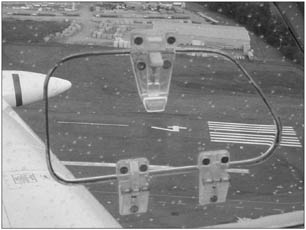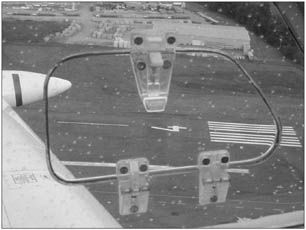
by Thomas P. Turner
The circling approach is way up there, maybe in the top spot, on most pilots lists of most risky instrument procedures. Were ingrained from about day three of our IFR training that the circling approach is one of the most hazardous tasks we are called on to fly. Add night to the mix and many pilots will decline flying the procedure at all. Airline standardization officers fear circling approaches. The military usually wont fly them. And yet, sometimes its the only way to get the airplane on the ground at our destination.
Perhaps recognizing this, the FAAs newest set of Practical Test Standards (FAA-S-8081-4D) for the Instrument Rating recently made the circling approach a mandatory component of the Instrument Proficiency Check (IPC) in an airplane, that ride you need to take with a Double-I once your six-month IFR currency expires.
So, what do we need to know about circling approaches to get through the IPC?
First, Why Circle?
Face it: were spoiled. We fly mainly ILS approaches, with maybe a localizer or GPS thrown in. Almost all of these procedures dump us out in a position from which very little maneuvering is required to reach the runway after going visual. However, terrain or airspace considerations often prevent a straight-in approach; sometimes clouds and surface winds make it preferable to fly an approach to one runway and land on another. For this reason, both precision and nonprecision approaches can end in a circle. If you cant fly /G (approach-certified GPS) and depend on NDBs and VORs that may be off the airport grounds, youll almost always approach the runway at an angle. For these airports, conditions and pilots we have the circling approach.
A circling approach is simply one where the final approach course is aligned more than 30 degrees off the heading of the runway on which youll land. By definition, there will be a phase of the approach where the airplane is maneuvered visually away from electronic course guidance to a point where the pilot can make a normal landing. Often this requires halting the airplanes descent in a landing configuration while maneuvering close to the ground at a relatively slow airspeed. The resulting unstabilized descent with tight turns flown in poor conditions near obstacles and terrain is the source of anxiety among IFR pilots. If the decision to include the circling approach in the IPC is any indication, its also of concern to the FAA.
Turning Radius
Perhaps the major challenge to performing the circling approach is flying the airplane at the right speed; faster airplanes have a wider turning radius than slower ones and circling minima will be higher at faster speeds than for lower ones.
The illustration on the next page shows the relative horizontal distances that must be cleared for airplanes flying in various approach categories, based on the speed they are actually flying during the circle. The faster the airplane, the farther it may be from the runway. In that event, a higher visibility requirement is imposed, as demonstrated on the plate for the ILS Runway 33 approach at Roanoke, Va. (Page 11). Since there may be taller obstacles farther from the airport, the minimum descent altitude may be higher for a faster airplane, also.
Of course, flying the airplane in its landing configuration in low visibility and/or beneath a low ceiling, perhaps at night, while attempting to stay visual with the runway means you need to be on your game. Youll need to fly your circle maneuver tightly enough to stay within protected airspace and to keep visual contact with the runway. Best results may require a continuous turn (i.e., not leveling the wings on a base leg) from downwind to your final approach. Fold in the need to ad-lib a missed approach procedure (more on that in a bit) and you can see the added workload of a circling approach.
Necessary Skills
During your IPC, the CFII will be looking at how you perform a variety of tasks, many of which can be demonstrated during the circling approach manuever. The sidebar at right includes both the FAAs objectives for demonstrating this task as well as some of the more common errors associated with circling approaches. To nail this portion of the IPC, youll need to demonstrate you have certain skills.
For example, the circle demands that you have a firm foundation in instrument flight in the airplane being flown. This means knowing how to turn the rapid descent leading to MDA into a level-flight circling maneuver on-speed and in the same aircraft configuration.
Also, the circle is no place to be fiddling with the GPS, looking up the MDA or reviewing the missed approach procedure. If something else is so important that you need to do it during the circle, delegate it to another qualified person aboard or miss the approach to sort things out.
Stick-and-rudder skills are also important. For example, theres a lot of similarity between a circling approach and short-field landings. Theyre flown close to the airport and require a relatively steep final approach. Youll need to compensate for winds and avoid drifting into a position that requires more than a 30-degree bank to stay on track. Of course, youll want to avoid a stall/spin. Maintain rudder coordination and avoid banking too steeply, which can lead to an accelerated stall.
Briefing The Circle
Briefing the circling approach includes everything youd review before any other type of approach. But, because of the additional manuevering and limitations, you also need to place special emphasis on the speed and resulting approach category at which youll fly the procedure. Since the circling manuever requires different minima than the straight-in proceedure, the slower and tighter you can fly the circle, the lower will be visibility requirements. You also need to determine the type of circling maneuver youll use.
Other stuff you need to do before leaving the FAF include identifying any obstacles along that circling path, including on final, verifying runway lighting and expected markings as well as any displaced threshold for the landing runway, and the point during your circle at which you can descend below MDA. Having this information ready when your CFII asks for it during the IPC helps demonstrate that you know what youre doing.
Descend Below MDA?
Its a common topic on aviation-related Internet chat lines-when can you descend below circling minimums? Typical answers are when in a position to make a normal landing and when within 30 degrees of the centerline of the landing runway. Whos right?
FAR 91.175 tells us …no pilot may operate an aircraft…at any airport below the authorized MDA …unless-(t)he aircraft is continuously in a position from which a descent to a landing on the intended runway can be made at a normal rate of descent using normal maneuvers…. The Pilot/Controller Glossary adds this non-regulatory phrase: …and adequate visual reference to required visual cues is maintained.
This leaves when can I descend below MDA? completely to the discretion of the pilot. For a little help in making your decision consider this: the standard circling MDA is 500 feet AGL (in rare cases they may be even lower). Break out right at minimums and youll be flying a low, scud-running traffic pattern. At what point in a normal, VFR circuit would you descend below 500 AGL? Thats about where youd expect to be when turning final in a tight traffic pattern. Hence the rule-of-thumb to hold circling altitude until within 30 degrees of the runway-the turn from base to final.
What if circling minimums for a particular airport are higher than 500 AGL? Undoubtedly this is due to an obstacle somewhere near the airport. Look at the 10-nm, to-scale ring on the approach plate and find the obstacle forcing the higher minimums. Once you see the runway and positively determine youre past the causal obstacles, visually descent below MDA to traffic pattern altitude, then continue a visual landing. Dont forget what youve briefed about displaced thresholds and obstacles on the approach path.
Youll need to authoritatively respond to your CFIIs question about descending from the circling MDA-now you know how.
Circling Styles
The illustration at left presents the many options you have in making a circling maneuver. Option A best describes an approach that is nearly, but not quite, aligned with the runway. Breaking out requires a modified base leg and, depending on the MDA and weather, a quick descent to landing.
Option B might be for the same approach but used when nearby obstacles make for an MDA high above field elevation, or a lower MDA with visibility right at minimums. Breaking out at the missed approach point high or close to the airport may require an upwind leg with a left or right pattern as appropriate, flown right at circling minimums.
Option C is the classic mid-field arrival common to circling approaches using off-airport navaids for guidance. Like Option B, this requires multiple tight turns close to the ground, with the accordant risks.
Option D is often flown to an airport served by a single approach when winds favor the opposing runway. This option employs fewer tight turns and sets you up for a more familiar-looking, albeit low and tight, visual traffic pattern. But it can expose you to unseen obstacles on the downwind leg.
Dont Forget The Miss
As instrument pilots were not used to having the authority to make up our own maneuvers, but a missed approach initiated during the circle requires that we do just that. Remember that you must keep the runway in continuous view during the circle (unless portions of the airframe temporarily block it during normal-bank turns) or you have to miss the approach.
Each of the four types of circling maneuvers illustrated on the opposite page include a constant-miss the approach at any point during a circle and youll need to turn toward the center of the airport and then maneuver as necessary to reestablish yourself on the missed approach course. Keep in mind that obstacle clearance is predicated on beginning at the missed approach point at MDA. Steer over the airport (the only known obstacle-free airspace in the vicinity) while you get above MDA and intercept the missed approach course.
Circling Not Authorized
In the briefing notes for the ILS Runway 33 approach at Roanoke, Va., youll see that circling northwest of Runway 6-24 is not authorized and in all cases circling to Runway 15 is NAd. Why?
In this case, the notes advise of mountainous terrain higher than airport in all quadrants. The Minimum Safe Altitude (MSA) from south of the Vinton NDB (the compass locator) around the west and north to due east of VIT is more than 4000 feet above airport elevation. The MSA in the remaining southeast quadrant is lower, but still 2200 feet AGL. Towers close to the airport create the prohibition on circling to Runway 15.
Other factors may prohibit circling approaches. Examples include lack of a local altimeter setting or weather reporting as well as absence of proper runway lighting or marking. Unlighted or known but not yet precisely charted obstacles (such as ever-sprouting cell towers) may restrict circling approaches, at least at night.
Are You Ready?
Theres no question that a circling approach involves greater risk than a straight-in ILS. That-and perhaps some alarming trends in the accident statistics-are probably why the FAA added the procedure to the IPC. Even if you never intend to circle in for-real instrument conditions, the FAA wants you to know how. Now you do.
Also With This Article
“Busting The Circle”
“Circling The Plate”
-Tom Turner is a CFII-MEI who frequently writes and lectures on aviation safety.




